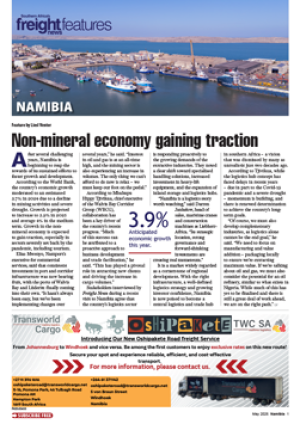Durban Harbour, the largest and busiest shipping terminal in sub-Saharan Africa, handles up to 31.4 million tons of cargo each year. It is the fourth largest container terminal in the southern hemisphere, handling 4 882 249 TEUs in 2018.
This figure seems impressive, however when compared to the smart port of Hamburg handling approximately 9 201 417 TEUs and impressive 66.8 million tons of cargo, this figure soon seems not nearly as impressive.
The Port of Durban is largely considered to be the “gateway” to Africa and in order to maintain and further enhance its performance, the introduction of smart technologies is a must.

According to Wikipedia, Industry 4.0 is the name given to the current trend of automation and data exchange in manufacturing technologies. It includes cyber-physical systems, the internet of things, cloud computing and cognitive computing. Industry 4.0 is commonly referred to as the fourth industrial revolution.
It is crucial for South African ports to adapt and employ smart technology in order to enhance global competiveness and remain the preferred choice of port for shippers.
With the Internet of things, smart ports and infrastructure developments at certain other ports on the West Coast of Africa, geographical location is not enough to remain competitive. Government stakeholders and private enterprises need to catalyse the process of automating our ports and integrating smart technologies in order to maintain competitiveness and avoid redundancy. While ideally located, the Port of Durban could face lose out on significant traffic as illustrated by the stats provided below.

Overall South Africa has performed reasonably well as per the Logistics Performance Index, however we have experienced a consistent decline in performance year on year and the development of our ports or lack thereof has been a significant contributor to this.
On average the Port of Durban has four to five container vessels per day calling at DCT Pier 2 and Pier 1; there is a dire need for the development of terminal infrastructure coupled with the introduction of smart technologies. The actual performance of our ports versus the target performance supports the need for converting our ports into smart ports. Quicker turnaround of vessels is imperative to ensure reduced operational costs, decreased delays in delivery lead times and an overall increased level of competitive service to importers, exporters and foreign investors.
We need to increase the attractiveness of South African ports by employing smart port technologies to avoid congestion at our terminals, taking a leaf out of the certain European smart ports like the ports of Hamburg, Rotterdam and Valencia that have rolled out the installation of black boxes to ensure accurate recording of data for reporting, employment of automated equipment for loading and discharging of containers, and the use of 5G technology to ensure optimisation to name but a few.
These ports initiated the installation of sensors on ships to transmit movement and environmental data in real time across large swathes of the port, for example.
Transnet National Ports Authority operating expenses increased to R4.5 billion in 2018; smart technologies would undoubtedly have reduced a significant portion of the long-term spend, thus having more money for berth deepening, allowing larger vessels to enter Durban. At a time where the world economic climate is uncertain, shippers want to reduce their logistics and transportation costs. With South African ports transforming into smart ports, we would see a greater volume of container traffic calling at our ports.
Advancements in technology has and will continue to drastically change the way business is conducted and organisations are run. Sophisticated technologies and advanced analytics are transforming the manufacturing industry and paving the way for increased efficiency and automation.
Industry 4.0 has been described as one of the most important disruptions for the manufacturing industry in recent times. The third industrial revolution, which saw the digitisation of manufacturing goods, introduced brand new technologies to increase efficiency. Industry Logistics 4.0 has introduced the connection between these technologies and the transportation of goods, how they interact with each other and how they interact with humans. Technologies such as Artificial Intelligence and smart ports can now communicate with one another and make decisions without human involvement.
Logistics 4.0 does not rule out human intervention altogether. The logistics, freight forwarding and shipping environment is still and will remain a people-orientated industry, Logistics 4.0 does however simplify and optimise the efficiencies of the overall logistics process. Major shipping lines have commenced with technological advancements to their businesses eg, the introduction of smart containers and virtual assistants to provide a value-added service to their customers, providing real time tracking updates on the exact whereabouts of the cargo in order to ensure better planning.
South African ports need to transform in order to achieve the ambitious performance targets set for 2019. As an industry role player, we too should look at mechanisms of incorporating smart technology into our everyday business.







